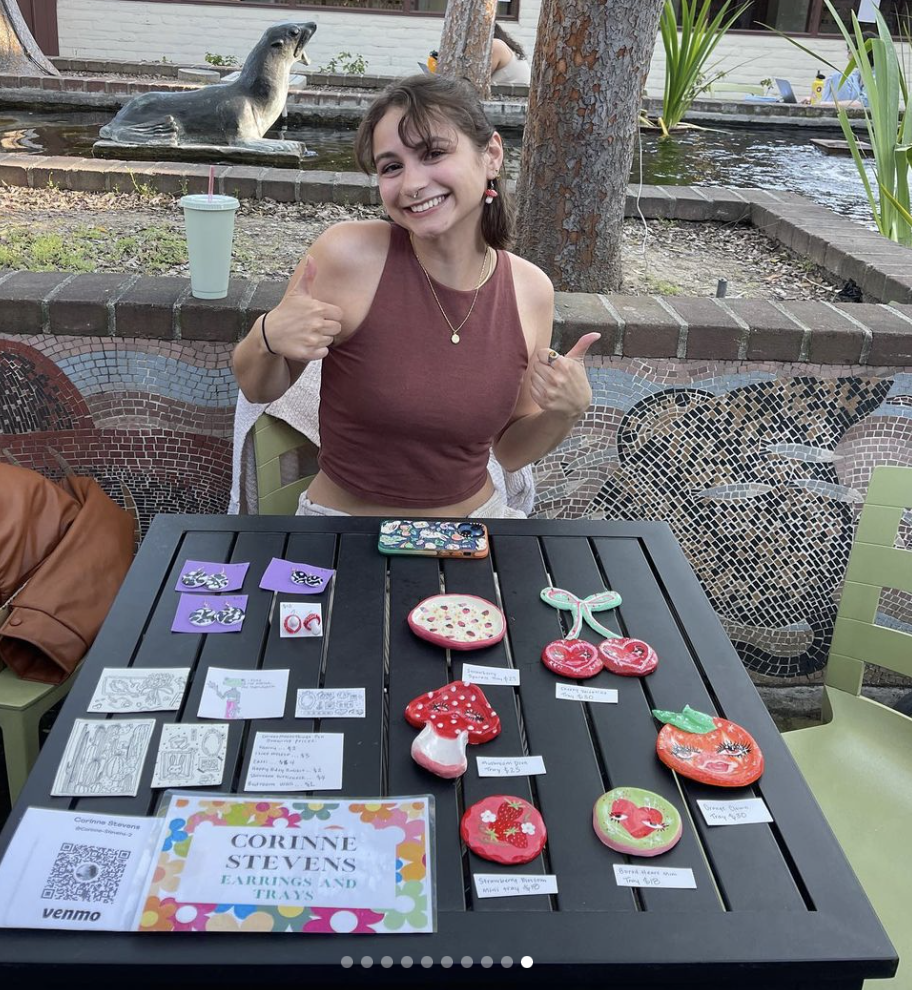AJ Jolish ’25
Staff Writer
Up until this semester, student art was available in the display case and on the counter by the door, and students were free to look through the offerings and Venmo artists directly for their work. Instead, the Motley now welcomes artists to set up booths for an art market in Seal Court once a month.
Avalon Brice ’24, the networking manager at the Motley, explained that theft was a large factor in the change. “It broke my heart to see student artist’s stuff being taken and them not being compensated for it, and it got to a point where the Motley was compensating for large amounts of people’s art,” she said. “I don’t have the capacity to constantly be monitoring what comes in and out, especially when it comes to student art. So I thought a monthly student art market would be like an easier way for that to function while still having student art being a large part of the Motley’s mission,” she continued.
Space in the Motley was also a concern, especially as COVID protocols were lifted, allowing the display case to return to its original use storing pastries. “At first we just accepted everyone who wanted to sell with us, and the only reason that I stopped accepting people was that we just didn’t have any space left,” explained Brice. “At one point last semester there were almost 40 people selling, and there’s not very much space over our little corner to have 40 people’s art.”
Some artists were disappointed to see the old setup go. Corinne Stevens ’24, who sells clay trays and earrings, was one of the first student arts to sell her work in the Motley. “When people could look at my work and come back day after day and see the same thing, and keep their eye on stuff, and really think about it, I felt like I made a lot of sales. I kept selling out of my stuff and it was really gratifying.”
Stevens participated in the Motley’s first market during their reopening. “It did not go well for me, I think just because some of my stuff is really detailed, and larger and more detailed trays are more expensive, so when you have that and somebody is just walking by and looking at it and thinking ‘ooh, that’s too expensive for me to buy right now,’ they’re not getting that exposure of ‘maybe I’ll save up for it’ or ‘maybe I’ll ask my mom to buy it for me for my birthday,’” Stevens said. “Or even if it’s just not the right people, like the people who would want to buy my stuff aren’t available to go to the market that night, then I’m not going to be able to sell anything.”
Eileen Kang ’26 had a more positive experience selling at the Motley’s opening market. “It’s a lot more engaging, and I like to see who’s buying my work, who’s interested, and being able to tell them more and give them the stories behind it,” she said. “Pieces of jewelry are very personal and very stylistic, and there’s more to it than just what it looks like. That aspect is really important and you don’t get that when you’re just dropping things off at a counter.”
The Motley held its second art market on April 6. As opposed to the opening, which had booths all around the koi pond and live music, this market filled only half of Seal Court and had music playing from a speaker. It also took advantage of the spring’s early evening sunlight.
The relaxed atmosphere of the market allowed students to circle the booths multiple times, stopping to chat with vendors and friends along the way. Each artist made the space their own; one vendor had two posters and a large laser cut piece for sale, while another covered two tables with expertly crafted crochet. The market ran from 5 p.m. to 8 p.m., and fielded a steady stream of attendees from all the 5Cs.
One of the vendors for whom this market was their first time selling with the Motley was Cassandra Aléman ’21, who makes handcrafted body butter. “Today has been really good. We’ve had a lot of interest: a lot of people joining the mailing list and a lot of people purchasing,” she said. “It’s so inspiring to be around other handmade craftspeople. You don’t get that many opportunities to do this sort of thing in real life.”
The fair also hosted many returning artists. Stevens, who had qualms after the opening fair, had a better experience at the latest one. “This definitely went a lot better. Having it be light out, warm, sunny, and during dinner time- and not having live music- helped if people were feeling like it was too much of a party,” she shared. “I sold a larger piece I’ve been wanting to sell for a while. I also reduced my prices a bit and started selling some smaller stuff for people to buy as they’re walking by. I still wish people got to see stuff more than once a month, but I don’t think it’s the market that’s the problem.”
Keep an eye out for future markets to buy impressive hand-crafted goods and support hardworking student artists.
Image Source: Instagram @corinnemakesthings



